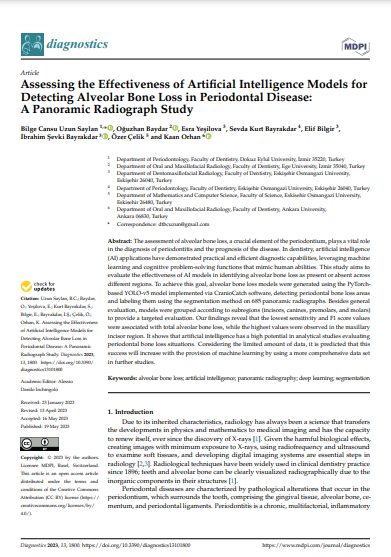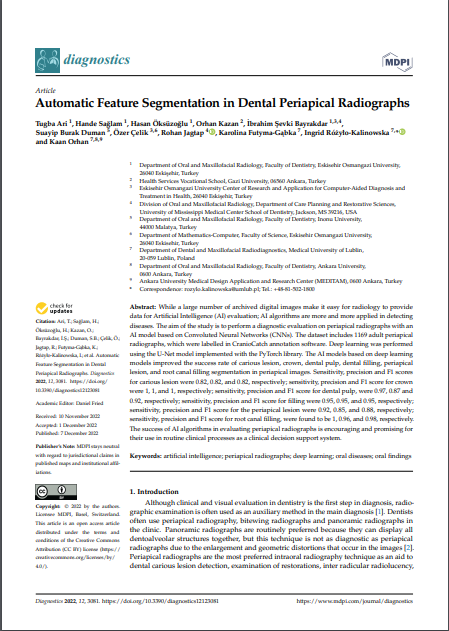Automatic Detection of Dentigerous Cysts on Panoramic Radiographs: A Deep Learning Study
Introduction
- Background: Odontogenic cysts and benign odontogenic tumors are usually painless and asymptomatic unless they grow large enough to cause significant issues. These lesions can often be identified through routine radiographic examinations.
- Problem: Accurate diagnosis of these lesions requires radiographic interpretation training and experience.
- Solution: Convolutional Neural Networks (CNNs) are increasingly used in medical imaging to assist in diagnosis. This study aims to develop a model for detecting dentigerous cysts on orthopantomographs (OPGs) to introduce dentistry students to AI applications.
Materials and Methods
- Data Collection: Two 5th-year dentistry students identified 36 OPGs with histopathologically confirmed dentigerous cysts.
- Image Processing: Images were resized to 1024x514 pixels, and augmented with vertical and horizontal flips for training-validation.
- Model Training: A U-Net CNN model was trained with 200 epochs using PyTorch, with a dataset split into 112 training images and 16 validation images.
- Evaluation: The model's performance was tested with new OPGs and evaluated for precision, sensitivity, and F1 score.
Results
- Performance Metrics: The model achieved a precision of 0.5, a sensitivity of 1, and an F1 score of 0.67.
- Example Detections: Figures show successful detection of dentigerous cysts attached to mandibular third molars.
Discussion
- Challenges and Limitations: The study's small sample size and the exclusion of cases without histopathological confirmation limited the model's sensitivity and accuracy. Public datasets are needed for broader testing.
- Comparison to Other Studies: Similar studies have achieved varying levels of success in detecting odontogenic lesions, with some reaching high sensitivity and specificity.
Conclusion
- Findings: The CNN model demonstrated potential for detecting dentigerous cysts even with a small dataset.
- Future Directions: Larger datasets and improved methods could enhance model accuracy, providing valuable diagnostic support for new dentists.
Acknowledgements and Contributions
- Contributions: E.O. and I.T. detected and segmented the cystic cavities, supervised by G.U. I.S.B. and O.C. processed the images and created the model.
- Conflict of Interest: None declared.
I Want to Write a Scientific Research Project
CranioCatch is a global leader in dental medical technology that improves oral care in the field of dentistry. With AI-supported clinical, educational, and labeling solutions, we provide significant improvements in the diagnosis and treatment of dental diseases using contemporary approaches in advanced machine learning technology.
CranioCatch serves thousands of patients with dental health issues worldwide every day with its innovative technologies. That’s why we eagerly look forward to meeting our valued dentists who wish to work in the field of 'Scientific Research in Dentistry'.



 Contact Us
Contact Us

